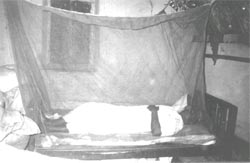Bednet or not?
Bednet or not?

malaria poses a serious public health problem in India with three million cases being reported every year. With the malaria-spreading mosquitoes becoming resistant to pesticides and the malaria parasite developing immunity to drugs, the problem is all the more threatening. One way to deal with it is the insecticide treated mosquito net ( itmn s). These nets treated with pyrethroid, an insecticide that simulates natural pyrethrins derived from chrysanthemum. itmn s and treated curtains reduce human-vector contact both by acting as a physical barrier and by repelling mosquitoes. The low cost and the ease with which these nets can be treated with insecticides make them very viable. But there are a few questions that need to be answered.
While some scientists believe that bednets promise good results in India, there are others who feel they may do more harm than good. "No fixed policy has yet been formulated, but bednets surely will get an important place in controlling vector-borne diseases,' says V P Sharma, consultant with the World Health Organisation and former director of the Malaria Research Centre ( mrc ).
"Bednets can only be used as a supplementary and cannot replace other methods of control such as indoor residual spraying ( irs ). Where they are being used as supplementary tool, they are still failing where issues of community awareness is not taken into account,' says M A Ansari, deputy director of mrc .
Extensive field trials have been conducted since the late 1980s to test itmn s as an alternative strategy for malaria control. The results of such trials have been contradictory. mrc conducted a few field trials to test itmn s in the north-eastern sector. Village-scale trials with insecticide impregnated nets were conducted in Sonapur primary health centre of Kamrup district in Assam. In one of the experiments conducted here between 1988 and 1990, malaria incidence decreased by 70 per cent in the intervention villages when compared with the baseline data, which was from the year 1987.
In 1993-94, similar trials were conducted in Jabalpur town of Madhya Pradesh and Rourkela in Bihar. The results were very different. "In Rourkela the results were quite encouraging, but they were not successful in Jabalpur, mainly because the community's participation was lacking,' says Ansari.
Many field trials have been undertaken in African countries that spell out the effectiveness of bednets in reducing malaria. Studies from Kenya and Ghana indicate that sleeping under itmn s could save the lives of 500,000 children each year.
As against these success stories, a group of scientists working for the Kenya Medical Research Institute in Nairobi and at the University of Oxford in the uk claim that bednets may do more harm than good in the worst-hit areas. They argue that immunity to malaria can decrease among children who sleep under bednets as infants. Older children may thus experience worse symptoms and ultimately the number of deaths from malaria could increase.
But why are some field trials successful while others fail? One reason could be the absence of a pricing system for bednets in India. People were given bednets free of cost, and when they were priced, the trials failed. Further studies of the sustainability and sales and distribution systems for nets and insecticides are essential. Till then the dilemma will continue and it will not be known if this simple method can save as many lives as some researchers would have us believe.







